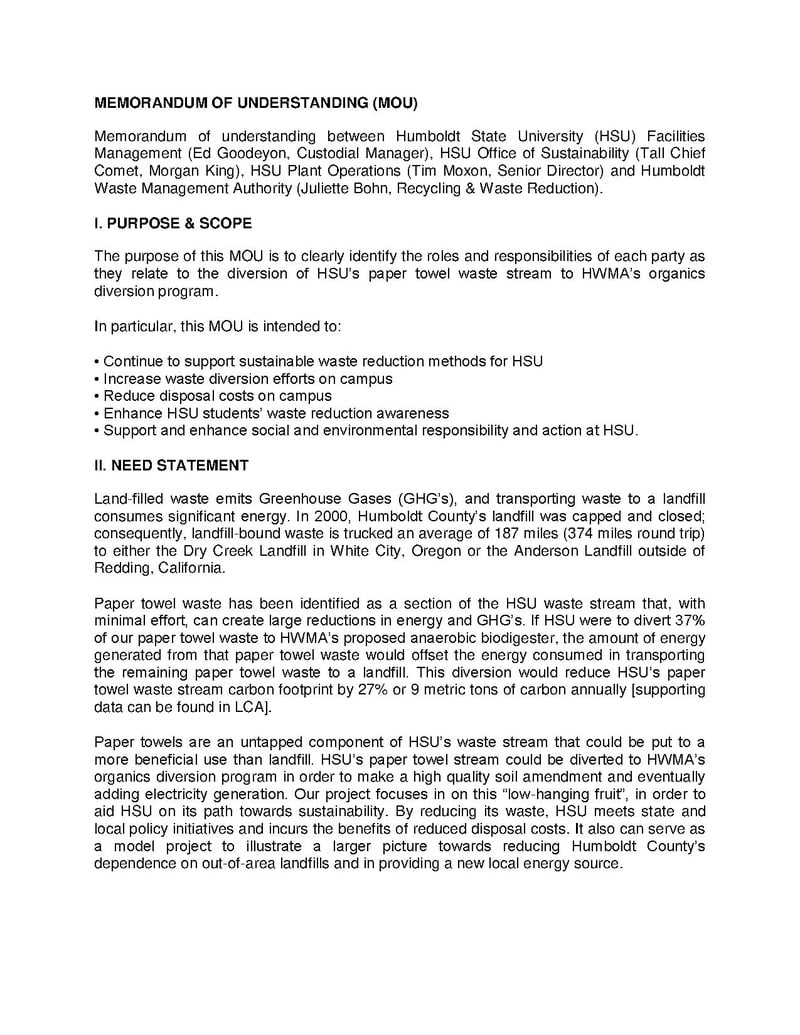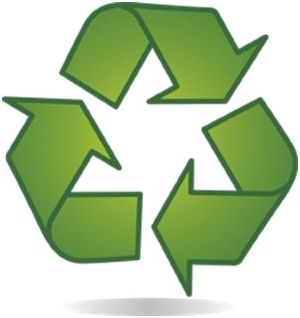
The 2012 Spring semester class of Engr370 Energy, Technology and Society continued the 2011 Cal Poly Humboldt Paper Towel Diversion Project. Phase II of the project culminates in a memorandum of understanding supported by documented research. This document asks participating stakeholders to take a vested interest in the project. The memorandum is not meant to be contractual but rather a step towards an easy facilitation of the project through understanding and agreement to the proposed elements of the project. The document is supported by further research into an effective paper towel collection system and a community based social marketing plan to change social norms on the campus. Teams were developed to work on each component and contribute to the final document. The following is a detailed outline of the project development and a summary of the final product.
Purpose and Context[edit | edit source]
The purpose of this project is to create a model for diverting Cal Poly Humboldt's paper towel waste. A second purpose to this study is to analyze the energy consumption of the current "business as usual" method and the proposed diversion alternatives.
Phased Approach[edit | edit source]
We recommend taking a phased approach, starting with one of four options for the first phase and collecting feedback to adapt and implement a second phase. In addition, we also have provided suggestions for signage and other community based social marketing.
Phase 1 - Pilot[edit | edit source]
Introduction
The success of the Paper Towel Diversion Project not only hinges on the participation of the students and faculty separating their restroom waste but also on the system employed to collect paper towels. A three step system with various alternatives was created to evaluate potential collection systems. Steps one and two define the scope and propose collection methods. Step three evaluates qualitative metrics associated with each option. This design was developed to allow flexibility and consider multiple stakeholder concerns.
Scales[edit | edit source]
The pilot project will be limited to a number of buildings on campus. To determine which buildings will participate in bathroom paper towel collection we have two alternatives:
Option A: Business As Usual. This first option is included to provide baseline data for all options and alternatives.
Option B: Mandated collection based on the percentage of paper towels generated of total paper towels generated on campus:
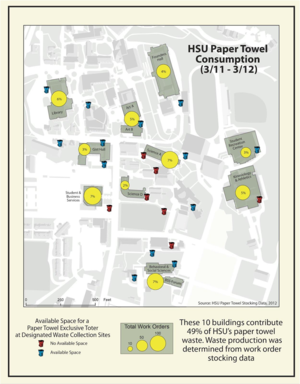
37% mandate[edit | edit source]
This option focuses on buildings that generate the greatest percentage of paper towel waste, are easily accessible, and have adequate space for a collection tote in the building waste collection site. It requires the custodial staff to have an active role in either of the three collection alternatives provided. This mandated custodian participation is similar to how recycling began on campus.
Building Percent generated by building Available Space for Tote at Dumpster Site
Student and Business Services 7%
Science A 7%
Behavioral and Social Sciences 7%
Library 6%
Art Complex 5%
Kinesiology & Athletics 5%
Total % collected 37% of HSU towel waste
This option focuses on buildings that generate the greatest percentage of paper towel waste, are easily accessible, and have adequate space for a collection tote in the building waste collection site. It requires the custodial staff to have an active role in either of the three collection alternatives provided. This mandated custodian participation is similar to how recycling began on campus.
24% voluntary[edit | edit source]
Selecting buildings on campus through voluntary willingness to participate in bathroom paper towel collection by custodian.
Building Percentage by building
Student Recreation Center 3%
Kinesiology & Athletics 5%
Science D 2%
Gist Hall 3%
Science A 7%
Founders Hall 4%
Total 24% of HSU towel waste
To alleviate any potential disputes with the custodial staff or their representing union, an addition option was created that allows custodians to opt into the program and pro-actively help in its development. It is highly suggested that an incentive is created to increase participation and the quality of custodial involvement.
Methods[edit | edit source]
The collection of bathroom paper towels from participating pilot project buildings has been broken down into three distinct stages:
Stage 1. In this stage pre-sorted paper towels will be removed from the bathroom and put into paper towel collection bins located at the building's respective waste collection site. The building custodian(s) will be instrumental in this process. Several alternatives can be selected with pros and cons to each.
Stage 2. The paper towels will be transported to one of two central collection sites. Currently we propose that paper towels should be combined with food waste in collection bins behind the Depot and J Dining Hall. Student assistants under the Office of Sustainability will be responsible for this stage. Alternative collection methods are listed below.
Stage 3. This stage addresses the possibility of processing the paper towels before adding it to the food waste. Processing may include removing paper towels from plastic bags, removing contamination, or discarding to landfill bins.
Dump[edit | edit source]
1. Collection: Bathroom bin --> Building Waste Collection Site (Paper Towel Tote): Paper towel bathroom bin liner removed from bathroom paper towel bin. Paper towel bathroom bin liner placed in custodians' paper towel collection bag. Collection bags placed in Tote. 2. Transportation: Tote-->Central Food Waste Dumpster: Student assistant collect Totes with flat-bed truck w/ lift gate (truck 89). 3. Processing: Central Food Waste Dumpster: Student assistant cuts collection bags of paper towel bags from totes, diverts contaminants.
This alternative would require a separate landfill bin on the cart, as well as a separate trash bin in the bathrooms.
Slash[edit | edit source]
1. Collection: Bathroom bin-->Building Waste Collection Site (Paper Towel Tote) Paper towels emptied from bathroom paper towel bin liner into custodians' paper towel collection bag. Paper towel collection bag compressed and placed in Tote.
This would require tamping of towels on cart, as well as separate landfill bin on the cart, as well as a separate trash bin in the bathrooms. 2. Transportation: Tote-->Central Food Waste Dumpster: Student assistant collect bags from totes into electric vehicle.
3. Processing: Central Food Waste Dumpster: Student cuts collection bags of paper towels, diverts contaminants.
Comparison Phase 1 options[edit | edit source]
HSU LCA Project Overview[edit | edit source]
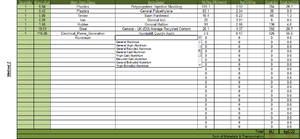
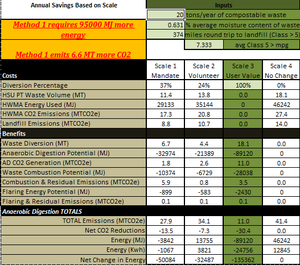
Land-filled waste emits Greenhouse Gases (GHGs) and transporting waste to a landfill consumes considerable energy. In 2000, Humboldt County's landfill was capped and closed; consequently, landfill-bound waste is trucked an average of 187 miles (374 miles round trip) to either the Dry Creek Landfill in White City, Oregon or the Anderson Landfill outside of Redding, California.
Our LCA uses the Waste Stream Diversion Table to examine the energy and carbon associated with Cal Poly Humboldt's (HSU) paper towel waste stream and the impacts of continuing with business as usual and various diversion scenarios to Humboldt Waste Management Authority's (HWMA) proposed anaerobic biodigester.
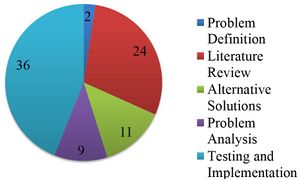
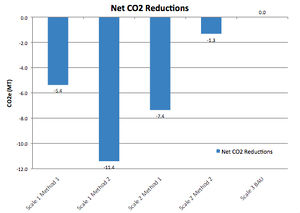
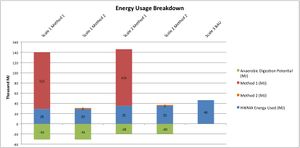
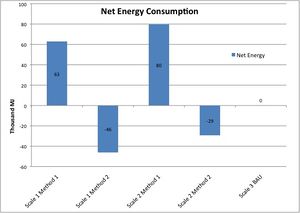
Community Based Social Marketing[edit | edit source]
We created a Community Based Social Marketing (CBSM) package for the paper towel waste diversion project.
Signage[edit | edit source]
To minimize signage on walls, we propose signs that would be attached directly to the bins. Two options were proposed to Marketing. The first would be a simple sign that says "Paper Towels Only." The second sign would say "Compostable," and would include the icon that HSU uses for compostable items.
Comic Strip[edit | edit source]
Here is a rough draft of a comic strip designed to raise awareness of how easy it can be to properly dispose of paper towels in the according bins. Potentially, it could be published in the Lumberjack newspaper.
Radio[edit | edit source]
Transcript:After you finish washing your hands you don't just look for the composting bin you look for a challenge. Under the bright lights of the bathroom you find your shot and score one for the team. The fans go berserk. When it comes to composting your paper towels, you are the king of the court. Even though you may go unnoticed you are more than willing to be a team player in the pursuit to divert our waste stream. Media:PaperTowelFinished.mp3
Video[edit | edit source]
Social Marketing video about composting in the Depot.
Memorandum of Understanding[edit | edit source]
In particular, this MOU is intended to:
- Continue to support sustainable waste reduction methods for HSU
- Increase waste diversion efforts on campus
- Reduce disposal costs on campus
- Enhance HSU students' waste reduction awareness
- Support and enhance social and environmental responsibility and action at HSU.
NEED STATEMENT:
Land-filled waste emits Greenhouse Gases (GHGs), and transporting waste to a landfill consumes significant energy. In 2000, Humboldt County's landfill was capped and closed; consequently, landfill-bound waste is trucked an average of 187 miles (374 miles round trip) to either the Dry Creek Landfill in White City, Oregon or the Anderson Landfill outside of Redding, California.
Paper towel waste has been identified as a section of the HSU waste stream that, with minimal effort, can create large reductions in energy and GHGs. If HSU were to divert 37% of our paper towel waste to HWMA's proposed anaerobic biodigester, the amount of energy generated from that paper towel waste would offset the energy consumed in transporting the remaining paper towel waste to a landfill. This diversion would reduce HSU's paper towel waste stream carbon footprint by 27% or 9 metric tons of carbon annually. Supporting data can be found in LCA.
Paper towels are an untapped component of HSU's waste stream that could be put to a more beneficial use than landfill. HSU's paper towel stream could be diverted to HWMA's organics diversion program in order to make a high quality soil amendment and eventually adding electricity generation. Our project focuses in on this "low-hanging fruit", in order to aid HSU on its path towards sustainability. By reducing its waste, HSU meets state and local policy initiatives and incurs the benefits of reduced disposal costs. It also can serve as a model project to illustrate a larger picture towards reducing Humboldt County's dependence on out-of-area landfills and in providing a new local energy source.
RESPONSIBILITIES UNDER THIS MOU
- HWMA will create a regional example of best practices for handling organic waste streams, building infrastructure capacity to accept those waste streams and provide regional policy leadership for waste reduction strategies.
- In a manner that is in compliance with custodial working condition agreements, HSU custodial services will collect paper towels from appropriate campus facilities and move them to designated collection bins outside of buildings; this will be implemented with a pilot study on a volunteer basis from individual custodians.
- HSU Sustainability Office, Campus Recycling operations is responsible for ensuring transport and/or aggregation of waste paper towels going to HWMA organics diversion program.
- Due to budget constraints, extra collection receptacles for collecting towels in all the buildings of campus in which those particular custodians have volunteered to be part of the pilot will be phased in according to available budget.
- Due to budget constraints, social change marketing and signage in order to promote paper towel diversion practices and decrease contamination of paper towel waste will be phased in according to budget.
- HSU may decide to start eliminating paper towels in bathrooms and start installing air dryers to meet waste and cost goals. If this or another method of reducing paper towel use is implemented, involved parties will be notified and discussions held, if warranted.
Stakeholders[edit | edit source]
- Juliette Bohn, Recycling & Waste Reduction, Humboldt Waste Management Authority (HWMA) - http://www.hwma.net/
- Cal Poly Humboldt - http://www.humboldt.edu/
- Tall Chief Comet and Morgan King, Office of Sustainability - http://www.humboldt.edu/green/
- Tim Moxon, Senior Director and Ed Goodeyon, Custodial Manager, Cal Poly Humboldt Facilities Management - http://web.archive.org/web/20160730075051/http://www2.humboldt.edu/facilitymgmt/index.html
Project Organization[edit | edit source]
The project was divided up into four core groups with a supervisor representing each group. The groups work independently on particular tasks. Team supervisors assist groups with work flow and maintain communication between groups. The whole project is overseen by Lonny Grafman, class instructor.
| Team 1 | Team 2 | Team 3 | Team 4 |
|---|---|---|---|
| Tanja Hopmans, Supervisor | Katie Harris, Supervisor | Joel Bisson, Supervisor | Joel Bisson, Supervisor |
| Aaron Gallo | Nicole Caputo | Robbie Di Paolo | Julian Keesee |
| Scott Kavanaugh | Scott Guy | Max Vecchitto | Eric Haas |
| Jeremy Battles | Josh Case | Kyle Stammerjohn | Robert Camacho |
| Ian Norton | Ben Fliegler | Roger Tuan |
- Team Cuties are researching and creating a community based social marketing program to support the project.
- Team G & J are writing and presenting a memorandum of understanding to project stakeholders.
- Team Radical Researchers are developing a paper towel collection system.
- Team Button Pushers are analyzing the collection system.
Notes[edit | edit source]
